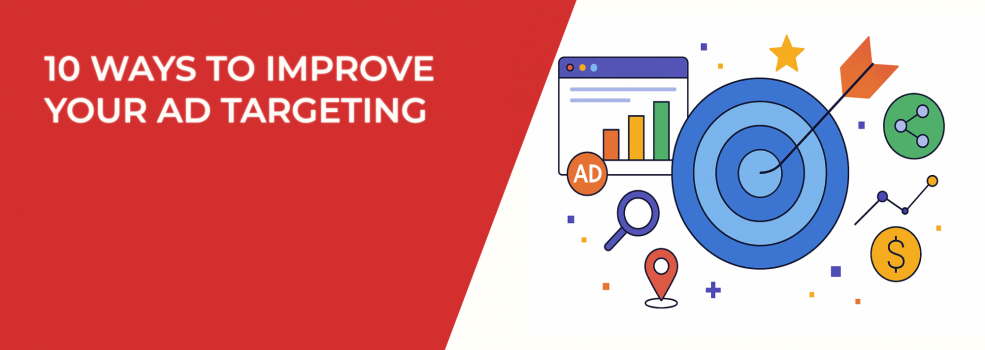Even the most creative ad will fail if it’s shown to the wrong audience. The visuals, copy, and offer matter — but the right targeting is what determines whether your budget is spent wisely or wasted.
Ad audience targeting is not just a technical step in campaign setup. It’s a strategic discipline that can dramatically reduce costs, improve click-through rates, and increase conversions. When it’s done well, every impression feels relevant to the person seeing it.
Below are 10 advanced yet actionable ways to improve your ad targeting, along with examples you can adapt to your campaigns.
1. Define Your Audience Beyond the Basics
Demographics alone — age, gender, income, and location — offer a starting point, but they rarely reveal the full picture.
A high-performing audience profile should also include:
-
Life stage: Are they students, first-time homeowners, mid-career professionals, or retirees?
-
Values and priorities: What matters most to them — price, quality, convenience, prestige?
-
Decision triggers: What events or needs prompt them to take action?
Professional insight: Use your CRM or customer database to analyze purchase patterns. Many businesses discover that their actual buyers differ from their assumed buyers.
Example: A mid-range furniture retailer might expect their main audience to be couples furnishing their first home. Data could reveal that a significant portion of sales comes from older homeowners redecorating specific rooms. That insight would reshape targeting and messaging entirely.
For a more detailed walkthrough on building a precise audience profile, see our step-by-step guide to defining a target audience for marketing.
2. Leverage Advanced Facebook Ad Targeting Options
Most advertisers only use the surface-level targeting features in Facebook Ads Manager. In reality, Facebook offers nuanced tools that can identify audiences by intent, behavior, and lifestyle.
Consider targeting based on:
-
Engaged Shoppers: People who have clicked “Shop Now” within the last week.
-
Life events: Recently moved, new job, engaged, or became parents.
-
Travel behavior: Frequent business or leisure travelers.
-
Device use: Differentiate between desktop and mobile or iOS and Android users.
Pro tip: Instead of layering many interests at once — which can over-restrict your audience — pair one strong interest with one relevant behavior.
Example: An online course provider could target “entrepreneurs” who are also “engaged shoppers” and have shown interest in productivity tools. This approach narrows the focus to people actively taking steps to improve their business.
If you want to explore every option available in Meta Ads Manager, our Facebook Ad Targeting 101 guide covers both the fundamentals and hidden features most advertisers miss.
3. Combine Interests and Behaviors for Strategic Precision
Interests suggest what people care about. Behaviors show what they actually do. Combining the two creates more targeted and effective segments.
Example: A luxury watch brand might target “frequent international travelers” and “fine dining enthusiasts.” This combination speaks to lifestyle and spending capacity, without relying solely on income targeting.
Advanced application: Use Facebook’s “Narrow Audience” feature to stack criteria in a way that prioritizes quality over reach. Then run A/B tests to compare each layered combination.
You can also take this further by using interest stacking techniques to build hyper-specific segments that outperform broad targeting.
4. Move From Broad Location Targeting to Micro-Geotargeting
Broad geographic targeting often wastes impressions. Micro-geotargeting allows you to serve ads to the exact locations where your audience lives, works, and spends time.
Ways to refine location targeting:
-
Target competitor locations: Show your ads to people who recently visited a competitor’s store.
-
Target event-based audiences: Use location targeting during conferences, festivals, or sports events.
-
Demographic layering within a radius: For example, homeowners within five miles of your store.
Example: A boutique fitness studio could target a 2-mile radius around luxury apartment complexes, ensuring that ads reach residents most likely to value premium wellness services.
Pro insight: Experiment with Facebook’s “People recently in this location” setting to reach tourists, business travelers, or event attendees in real time.
For more ideas on refining local targeting, see our hyper-local Facebook ad targeting strategies.
5. Customize Ad Creatives by Segment
Even within a single target audience, subgroups respond to different visual and messaging styles. Creating tailored ad variations ensures relevance.
Examples of creative customization:
-
Young professionals: fast-paced videos highlighting lifestyle benefits.
-
Parents: solution-focused messaging that addresses family needs.
-
Retirees: trust-building testimonials and clear explanations of value.
Professional tip: Even minor creative changes — such as swapping images, headlines, or calls-to-action — can meaningfully improve performance for different segments without increasing production costs.
6. Implement Retargeting Based on Engagement Depth
Retargeting is most effective when it reflects how users engaged with your brand, not just whether they visited your site.
Segment retargeting audiences into:
-
Light engagement: Visitors who viewed one page or short videos. Show low-commitment offers or educational content.
-
High engagement: Visitors who read multiple articles, watched long videos, or explored pricing. Present a strong, specific offer.
-
Purchase intent: Cart abandoners or quote requesters. Use urgency, incentives, or reminders.
Example: A travel agency could retarget users who viewed multiple destination pages with a tailored “destination guide” ad, then follow with a limited-time booking promotion.
To set this up efficiently, follow our step-by-step guide to Facebook retargeting — it includes methods for segmenting warm audiences by behavior.
7. Prevent Audience Overlap and Self-Competition
When audiences overlap, your campaigns can end up competing against each other in the ad auction. This often inflates costs without improving results.
How to address overlap:
-
Use Facebook’s Audience Overlap tool to measure shared audience percentages.
-
Merge overlapping segments into one campaign when possible.
-
Apply exclusions so that a person only sees the most relevant campaign.
Audience overlap can quietly drain budget; here’s a deeper look at how audience overlap impacts Facebook ads performance and how to manage it.
8. Apply Exclusion Targeting to Focus Spend
Exclusion targeting is an underused way to improve efficiency. By actively removing irrelevant or low-value audiences, you protect your budget for the most promising leads.
Potential exclusions:
-
Current customers in prospecting campaigns.
-
Low-intent users (e.g., people who regularly engage with discount-only offers).
-
Employees of competitor companies.
Example: A premium skincare brand might exclude users who consistently interact with budget cosmetics brands, as they are unlikely to convert at a higher price point.
9. Establish a Rapid Testing Framework
A slow testing cycle delays optimization. Instead, build a short, repeatable process for testing audience combinations.
Suggested framework:
-
Run 3–5 small-budget campaigns with different targeting setups.
-
Evaluate results after 3–5 days using key metrics beyond CTR — such as cost per qualified lead or customer acquisition cost.
-
Scale the best performers, pause the weakest, and iterate.
Professional insight: Higher CPC does not always mean worse targeting. In many cases, higher-cost clicks lead to more valuable conversions.
10. Explore Untapped Channels and Formats
Over-reliance on a single platform can limit growth. Diversifying targeting efforts across channels often uncovers fresh, less competitive audiences.
Examples of alternatives:
-
YouTube Ads: For educating prospects with detailed explanations.
-
Reddit Ads: For highly specific interest groups and communities.
-
Spotify Ads: For targeting based on listening habits and lifestyle.
Example: A B2B SaaS platform could run LinkedIn ads to decision-makers while also targeting YouTube search queries like “how to streamline invoicing.”
Closing Thoughts
Refining ad targeting is both an art and a science. It demands data analysis, but also creativity in defining who your audience truly is and how to reach them at the right moment. The better you align your targeting with real buyer behavior, the more your ads feel like a natural fit — and the less you have to persuade.
The most effective campaigns don’t try to reach everyone. They focus on the right people, in the right place, with the right message.

